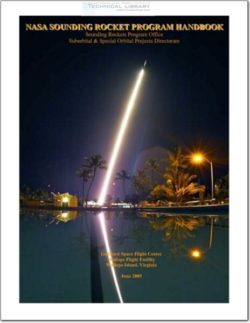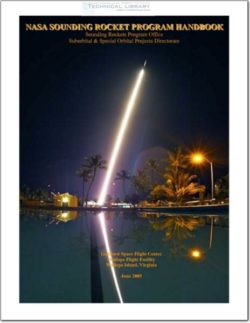NASA-810-HB-SRP

- Version
- 199 Downloads
- 5.39 MB File Size
- 1 File Count
- May 14, 2016 Create Date
- May 14, 2016 Last Updated
Sounding Rocket Program Handbook

Preface
This Handbook describes the capabilities of the Sounding Rocket program, the design and
technology applications used by that program, and the processes established to integrate the
customer (principal investigator/program user/scientist/experimenter) into the mission team
to ensure the highest probability of a successful project.
Neither the United States Government nor any person acting on the behalf of the Unites
States Government assumes any liability resulting from the use of information contained in
this document or warrants that the use will be free from privately owned rights.
The use of a company name does not imply approval or recommendation of the product to
the exclusion of others that may also be suitable.
SECTION 1: The NASA Sounding Rocket Program (NSRP)
This Handbook was written to assist NSRP customers in developing payloads that meet the
requirements necessary to achieve mission-specific, scientific objectives, and to serve as a
guideline in defining NSRP quality standards and ISO 9001-2000 requirements. For the
purposes of this document, “Customers” shall include principal investigators, program users,
scientists, and experimenters.
1.1 The Program: 1959 — the Present
The NSRP is a suborbital space flight program that primarily supports NASA—sponsored
space and earth sciences research activities, other government agencies, and international
sounding rocket groups and scientists. Since its inception in 1959, some 2800 missions have
flown with an overall science mission success rate exceeding 86 percent and a launch vehicle
success rate of over 95 percent. The program is a low—cost, quick—response effort that
currently provides 20 — 30 flight opportunities per year to space scientists involved in upper
atmosphere, plasma physics, solar physics, planetary atmospheres, galactic astronomy, high
energy astrophysics, and micro—gravity research. These rockets are launched from a variety of
launch sites throughout the free world.
In mid 1980, the NSRP was consolidated at the Wallops Flight Facility of the Goddard Space
Flight Center. The program has continued to grow in terms of average payload size, weight,
complexity, and range. NSRP flight systems are remarkably sophisticated spacecraft,
capable of lofting 1000 pound payloads to 280 kilometers and 250 pound payloads to 1500
kilometers.
NSRP customers consist primarily of university and government research groups; however,
some research activities involve the commercial sector. The program has contributed major
scientific findings and research papers to the world of suborbital space science, validated
satellite tracking and instrumentation, and served as a proving ground for space ship and
space station components. Many new scientists have received training and developmental
experience through NSRP internships and graduate study programs offered by participating
educational institutions.
| File | Action |
|---|---|
| NASA-810-HB-SRP Sounding Rocket Program Handbook.pdf | Download |

Comment On This Post